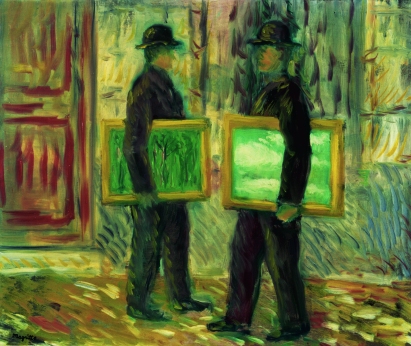One summer day several years ago I spotted on the Mills College campus (where I worked at the time) a Muslim woman dressed in a long narrow skirt and tunic top both in a lightweight fabric and in a lovely shade of mauve. Her hijab was pale purple, which blended so nicely with the mauve. She was wearing a pair of high heel sandals in tan and carried a tan satchel handbag. She looked chic and I wanted to talk to her and take her photo for the blog but she was a visiting professor and I didn’t want to intrude.
That woman is still vivid in my mind because it was then that I realized that 1. I hadn’t given Muslim dress much thought and 2. Muslim dress can be chic.
Of course it can!

Design by Nzinga Knight, the first contestant on Project Runway to wear a hijab.
I have been thinking about this form of dress ever since and so I was excited to attend the press preview for Contemporary Muslim Fashions, the current fashion exhibit on now at the de Young Museum in San Francisco.
“… modest fashion, or clothes that allow the wearer to remain relatively concealed but also appear stylish, has become one of the most pervasive international fashion stories in the past five years,” say exhibit curators, Jill D’Alessandro and Laura Camerlengo. When young Muslim women took to the Internet and blogging after not seeing themselves reflected in mass media, mass media took notice. As modest dress designers began to reach for a broader global appeal, the fashion industry took notice.
Reina Lewis, Professor of Cultural Studies at London College of Fashion and consultant to this exhibit says that the Muslim market for modest fashions is estimated at 44 billion US dollars this year and is expected to grow. “The style parade of cool Muslim women, often recognizable by their wearing a head-cover of some sort, is becoming a significant style story,” she explains. “If you are a trend forecaster, it is not hard to spot this vibrant cohort.”
They’re on it – H&M, Uniqlo, and Nike among others have recently produced items for modest dress.

Designs by Itang Yunasz using Indonesian ikat fabric. These remind me very much of Yves Saint Laurent.
With 80 ensembles representing 53 designers from the Middle East, Indonesia, Malaysia, Europe, Canada, and the United States, Contemporary Muslim Fashions is the first extensive museum exploration of Muslim modest dress and the influence it’s having on fashion around the world. Featured are day wear, sportswear, formal, and Haute Couture. Additionally there are photographs and videos to help contextualize the fashions on display.
Several of the included designers traveled to San Francisco to join the opening celebrations. I spoke with Indonesian designer Itang Yunasz, who was pleased to be part of this notable exhibit. Yunasz began his fashion career 37 years ago designing exclusive luxury clothing for women. In 2000 he chose to include modest dress in his collections to offer luxury and style for Muslim women who wish to dress modestly. He soon became known as the “Modest Wear Trendsetter.” Yunasz’s signature look is combining luxury with references to his native country. “I’m always designing with a touch of Indonesia,” he explained. Included in the exhibit are pieces made of handwoven ikat fabric, an Indonesian technique in which the fabric pattern is formed by weaving individual dyed yarns. For drape and flow in his silhouettes he also used silk, printed or digitized from ikat fabric. (Pictured above.)

Another designer from Indonesia, Khanaan Luqman Shamlan uses batik fabric, which is a wax-resist dye technique. Shamlan’s family owned a batik fabric factory and with that background she is determined to “see batik go global.”
Each region represented has varying styles and bring their own cultural differences to their designs. The Middle East might be more austere, Malaysia more colorful. There are examples of simple and ornate pieces, even tailored and whimsical. Not all ensembles include a headscarf as not all Muslim women wear one. Something I learned is that couture houses have for many years custom altered their designs for Muslim clients. On display are several couture gowns altered to fit the needs of Her Highness Sheikha Moza bint Nasser Al Missned, of Qatar.
Looking at the array of designs, it occurred to me that without the hijab some of these ensembles don’t read specifically Muslim and might appeal to any fashionable woman. For example Khanaan Luqman Shamlan’s designs pictured above are just beautiful gowns. Indeed, Professor Lewis commented that many of the designers included in this exhibit reported to her that 40 to 50 percent of their customers are not Muslims, but women of other faiths or women of no particular faith.

Another example of a design that fits modest needs but is also avant garde and might appeal to a variety of women. By Mashael Al Rajhi from Saudi Arabia. Merino wool, velvet.
There is much to learn from Contemporary Muslim Fashions about different cultures, different women, and how we can all meet at the intersection of fashion and style.
Contemporary Muslim Fashions is on now through January 6th, 2019. Click here for more information.













